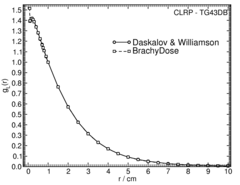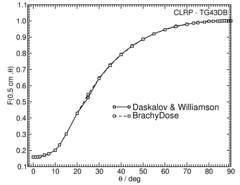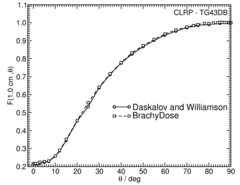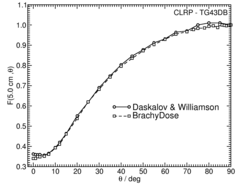

Source Description:
Seed dimensions for the BEBIG GmbH 103 Pd seed are taken from the paper by Daskalov and Williamson 1 . This source consists of 103 Pd uniformly distributed throughout a 3.50 mm long cylindrical alumina (Al 2 O 3 ) core with inner and outer diameters of 0.250 mm and 0.600 mm, respectively. For the purpose of these calculations the amount of 103 Pd present in the alumina is assumed to be negligible. Within the core is a 3.50 mm long gold rod with a diameter of 0.200 mm. The core is encapsulated in a titanium tube with 0.050 mm thick walls and 0.800 mm outer diameter. The end welds are slightly concave and have a thickness of 0.435 mm in the middle. End welds are modelled using a 0.400 mm Ti hemisphere overlapped with a 0.806 mm air sphere with its center shifted by 0.846 mm relative to the Ti sphere. The overall source length is 4.56 mm and the active length is 3.50 mm. The cylindrical source element is free to move 0.050 mm radially and a negligible amount along the seed axis.
Dose Rate Constant - Λ :
Dose rate constants, Λ , are calculated by dividing the dose to water per history in a (0.1 mm) 3 voxel centered on the reference position, (1 cm,Π/2), in the 30x30x30 cm 3 water phantom, by the air kerma strength per history (scored in vacuo ). As described in ref. 2 , dose rate constants are provided for air kerma strenth calculated using voxels of 2.7x2.7x0.05 cm 3 (WAFAC) and 0.1x0.1x0.05 cm 3 (point) located 10 cm from the source. The larger voxel size averages the air kerma per history over a region covering roughly the same solid angle subtended by the primary collimator of the WAFAC 3,4 at NIST used for calibrating low-energy brachytherapy sources and is likely the most clinically relevant value. The small voxel serves to estimate the air kerma per history at a point on the transverse axis.
| Author | Method | Λ (cGy h-1 U-1) | Abs. Uncertainty |
| R. E. P. Taylor, D. W. O. Rogers 5 | WAFAC | 0.685 | 0.002 |
| R. E. P. Taylor, D. W. O. Rogers 5 | point | 0.681 | 0.005 |
| G. M. Daskalov, J. F. Williamson 1 | extrap. (PTRAN) | 0.664 | 0.017 |
| G. M. Daskalov, J. F. Williamson 1 | WAFAC (PTRAN) | 0.660 | 0.017 |
Radial dose function - g(r):
The radial dose function, g(r), is calculated using both line and point source geometry functions and tabulated at 36 different radial distances ranging from 0.05 cm to 10 cm. Fit parameters for a modified polynomial expression are also provided 6 .
| Fitting coefficients for g L (r) = (a 0 r -2 + a 1 r -1 +a 2 + a 3 r +a 4 r 2 + a 5 r 3 ) e -a 6 r | ||||||||
| Fit range | Coefficients | |||||||
| r min (cm) | r max (cm) | a 0 / cm 2 | a 1 / cm | a 2 | a 3 / cm -1 | a 4 / cm -2 | a 5 / cm -3 | a 6 / cm -1 |
| 0.10 | 10.00 | 1.9287E-03 | -4.7847E-02 | 1.7588E+00 | 1.3311E-01 | -4.0432E-02 | 2.9659E-03 | 5.9250E-01 |
Anisotropy function - F(r,θ):
Anisotropy functions are calculated using the line source approximation and tabulated at radii of 0.1, 0.15, 0.25, 0.5, 0.75, 1, 2, 3, 4, 5, 7.5 and 10 cm and 32 unique polar angles with a minimum resolution of 5°. The anisotropy factor, φan (r), was calculated by integrating the solid angle weighted dose rate over 0° ≤ ϑ ≤ 90° .
References:
1. G. M. Daskalov, J. F. Williamson, Monte Carlo-aided dosimetry of the new Bebig IsoSeed 103 Pd interstitial brachytherapy seed, Med. Phys., 28 , 2154 -- 2161, 2001
2. R. E. P. Taylor et al , Benchmarking BrachyDose: voxel-based EGSnrc Monte Carlo calculations of TG--43 dosimetry parameters, Med. Phys., 34 , 445 -- 457, 2007
3. R. Loevinger, Wide-angle free-air chamber for calibration of low--energy brachytherapy sources, Med. Phys., 20 , 907, 1993
4. S. M Seltzer et al , New National Air-Kerma-Strength Standards for 125 I and 103 Pd Brachytherapy Seeds, J. Res. Natl. Inst. Stand. Technol., 108 , 337 -- 358, 2003
5. R. E. P. Taylor, D. W. O. Rogers, An EGSnrc Monte Carlo-calculated database of TG-43 parameters, Med. Phys., 35 , 4228--4241, 2008
6. R. E. P. Taylor, D. W. O. Rogers, More accurate fitting of 125 I and 103 Pd radial dose functions, Med. Phys., 35 , 4242--4250, 2008
Carleton Laboratory for Radiotherapy Physics
December 17 2007.




